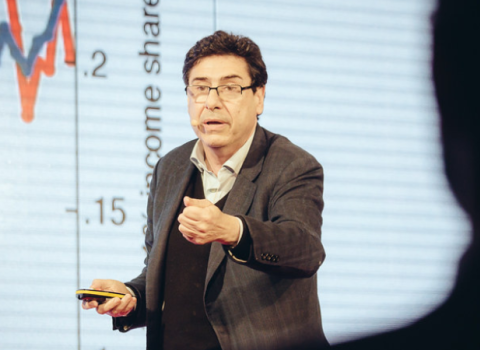
Harvard President Drew Faust: “Suddenly, those who train in America have significant options elsewhere.”
And one of the country’s leading scientists, Nobel Laureate David Baltimore, says the “criminal” cuts could undermine the country’s biotechnology industry.
Earlier this month restive scientists published a report warning the US stands to lose a generation of young researchers – and the medical treatments they could discover – if the current spending freeze continues. The NIH budget has not risen for the past five years, representing a 13 per cent fall in real terms.
The report, “A Broken pipeline? Flat funding of the NIH puts a generation of science at risk” (www.brokenpipeline.org), features 12 young researchers from across the country who despite impeccable credentials are having difficulty getting research grants. The situation is holding back scientific progress, and forcing many of their peers to leave academic research, it says.
While news of the funding standstill is not new, to date most attention has focussed on the effect on heavyweight, senior scientists. But it is young researchers that are bearing the brunt, according to Robert Golden, Dean of the University of Wisconsin School of Medicine and Public Health. “Junior investigators […] are competing for funding with established researchers who are their mentors, and finding the financial support just isn’t there, or that they can’t afford to support themselves whilst writing and rewriting grant proposals.”
The report is written by institutions including Harvard, University of California Los Angeles, Duke University and Brown University. They warn that unless the NIH gets consistent and robust support the US “will lose scientists to other careers and other countries”.
Biological research “a dead end”?
No less a figure than the President of Harvard, Drew Faust, says, “This is a real problem, discussed at almost every meeting I attend on campus that simply can’t be dismissed.” He believes young researchers are getting the message biomedical research “may be a dead end”.
Not only that, Faust also believes the US system may have lost its magnetic attraction to the best scientists around the world. “We have in-sourced talent, combined it with our own, and pushed the boundaries of innovation for our economy,” Faust told the Senate Committee on Health, Education, Labor and Pensions at a hearing earlier this month.
But today, China, India, Singapore and others have adopted biomedical research and the building of biotechnology clusters as national goals. “Suddenly, those who train in America have significant options elsewhere,” said Faust.
Junior researchers, typically of assistant and associate professor status, trying to establish their own laboratories, are getting a smaller piece of the NIH funding pie.
No doubt the effect of holding NIH spending level after a doubling of the budget between 1998 and 2003 is bound to be a shock. This vast expansion supported programmes such as the Human Genome Project that threw up an embarrassment of new drug targets. It also inspired the NIH Roadmap for medical research in the 21st century, initiated in 2002, which aims to increase the rate of translation of research from the lab bench to the bedside.
But since the budget was frozen in 2003, the NIH has been hit by a 13 per cent cut in spending power.
At present, only one grant in ten is funded at the first pass. Rejected grants that need to be revised and resubmitted are clogging the system and leaving young researchers stuck in a queue – and in career limbo.
A bad time to cut
In his Presidential address to the American Association for the Advancement of Science meeting in Boston last month, Baltimore said the spending freeze had decimated “one of the jewels of American science”.
He added, “It is criminal at a time when the opportunities in biomedical research outstrip any other moment in history.”
Overall, the success rate for NIH research grant applications dropped from 32 per cent in 1999 to 24 per cent in 2007. And while only one application in four wins funding, many that are approved get less than they asked for, often after long delays and reapplications.
Another consequence is that scientists reviewing grants are older – and it is alleged – more conservative. According to the report, this is changing the way science is conducted, “Discouraging innovative, big ideas, in favour of safer approaches.”
Faust told the Senate Committee on Health, Education, Labor and Pensions that one of the links in the innovation chain is “wearing thin”, as the careers of young scientists are stifled. “[They] are stuck behind their mentors in a funding queue that is stifling promising careers in academic research and pushing many with substantial promise to seek alternative paths.”
In his testimony to the Senate Committee, Ed Miller, Dean of the Johns Hopkins Medical Faculty and CEO of Johns Hopkins Medicine, said the university has seen a fall in NIH awards since 2005. “This is having an impact across our entire institution, but has a particularly insidious effect upon young investigators.”
This furore needs to be put in context. Despite flatlining for the past five years, the NIH will still get to spend $30 billion on research this year. That not only puts the R&D budgets of every other country (and continent) in the shade, it also far above the budget of any other US research agency.
No doubt, this financial firepower will continue to generate important, fascinating and medically and commercially significant results.
And if the fact that others are sharpening up their act challenges the US position as the primary destination for the best and brightest researchers, this competition could be good for science, medicine and innovation as a whole.





 A unique international forum for public research organisations and companies to connect their external engagement with strategic interests around their R&D system.
A unique international forum for public research organisations and companies to connect their external engagement with strategic interests around their R&D system.